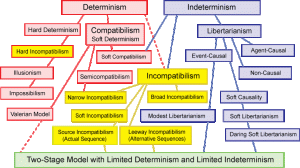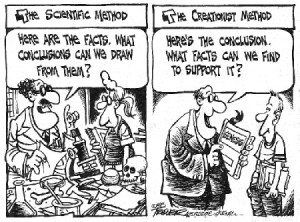joey, what you say here:
I agree with.
– –
This, I wrote yesterday after my post @ $98 where I left to read Quining Qualia, on recommendation by consciousness razor.
It is bullshit, cr. It is not logical, and even Dennet says so. It’s all there.
– –
lipstick:
1) have a will for doing something, in which case you have to deal with this regress*, which you cannot deal with — thus it is not freely willed — or
2) have no will for doing something — thus it is not freely willed.
*Why does the indeterministic mind prefer to do X instead of not-X? Where did it get that preference? Yet again there’s an infinite regress, which can be halted by saying the mind came into existence with certain preferences pre-packaged, but then the mind didn’t freely will those preferences.
A decision can be the result of multiple preferences, and each preference can be the result of causality. But why does that have to mean the actual choice between the preferences cannot be freely chosen?
In fact, IT CAN.
I linked to one of many similar papers by an fMRI researcher that said that there is no locus of thinking or decision making in our brains.
Do you people understand that? there is no point at which a ‘decision’ is finalized.
– – –
Guess what? I am going to perform the thought experiment about going back to the exact point in time and seeing if I could have chosen otherwise:
I was walking home yesterday, and I became aware of my trajectory, and how I arrived at it. So I started paying attention to how I decided my vector – that is my direction and speed.
At no point did I ever reach a decision making end point.
At no point, in time, did I reach a final decision that I could not change if I wanted to.
Never did that happen, that I could not decide, FREELY, where I was going to step next, NOT UNTIL MY FOOT ACTUALLY PLANTED ON THE GROUND.
I could decide at any point to halt my movements if I so desired, in which case I would have mistepped, and at no time was I ever considered TO BE COMMITTED IN MY DECISION!
*AA)
The answer is YES, I could have chosen otherwise, within 5 one hundredths of a second, or thereabouts. Okay, up to 20/100 s.
ESTIMATION OF RESPONSE TIMES
USING A THREE FUNCTION WEIBULL DISTRIBUTION
The best reaction times are always faster for auditory signals rather than visual signals. This has been confirmed by a number of laboratory experiments where the mean auditory reaction times are 140-160 ms (0.14-0.16 sec) and visual reaction times being 180-200 ms (0.18- 0.2 sec.)
The response times to self generated thought is probably faster. That means that when another idea enters the picture, like volitionally altering my chosen behavior, the original impulse, or ‘decision’, can be circumvented, I estimate, any time beginning at .2s by introduction of alternative though or evaluation parameters into the decision loop.
– – –
*BB)
I can prove that free will is not only possible, that it is likely.And I Stated explicitly, in # 38, that this was a wickedly good resource for understanding the complexity and multi-directional, non-localized interactions in the function of the brain:Nonlinear dynamic causal models for fMRI
This paper presents a nonlinear extension of DCM that models such processes (to second order) at the neuronal population level. In this way, the modulation of network interactions can be assigned to an explicit neuronal population. We present simulations and empirical results that demonstrate the validity and usefulness of this model. Analyses of synthetic data showed that nonlinear and bilinear mechanisms can be distinguished by our extended DCM. When applying the model to empirical fMRI data from a blocked attention to motion paradigm, we found that attention-induced increases in V5 responses could be best explained as a gating of the V1 → V5 connection by activity in posterior parietal cortex. Furthermore, we analysed fMRI data from an event-related binocular rivalry paradigm and found that interactions amongst percept-selective visual areas were modulated by activity in the middle frontal gyrus. In both practical examples, Bayesian model selection favoured the nonlinear models over corresponding bilinear ones.
OUR THINKING IS NOT LINEAR. It is not ‘one cause, one effect.’
– – –
*CC)
A brief thought can modulate activity in extrastriate visual areas: Top-down effects of refreshing just-seen visual stimuli:
Current models of executive function hold that the internal representations of stimuli used during reflective thought are maintained in the same posterior cortical regions initially activated during perception, and that activity in such regions is modulated by top-down signals originating in prefrontal cortex. In an event-related functional magnetic resonance imaging study, we presented participants with two pictures simultaneously, a face and a scene, immediately followed either by a repetition of one of the pictures (perception) or by a cue to think briefly of one of the just-seen, but no longer present, pictures (refreshing, a reflective act). Refreshing faces and scenes modulated activity in the fusiform face area (FFA) and parahippocampal place area (PPA), respectively, as well as other regions exhibiting relative perceptual selectivity for either faces or scenes. Four scene-selective regions (lateral precuneus, retrosplenial cortex, PPA, and middle occipital gyrus) showed an anatomical gradient of responsiveness to top-down reflective influences versus bottom-up perceptual influences. These results demonstrate that a brief reflective act can modulate posterior cortical activity in a stimulus-specific manner, suggesting that such modulatory mechanisms are engaged even during transient ongoing thought. Our findings are consistent with the hypothesis that refreshing is a component of more complex modulatory operations such as working memory and mental imagery, and that refresh-related activity may thus contribute to the common activation patterns seen across different cognitive tasks.
These results demonstrate that a brief reflective act can modulate posterior cortical activity in a stimulus-specific manner, suggesting that such modulatory mechanisms are engaged even during transient ongoing thought
OUR THINKING IS MULTI-DIMENSIONAL (multiple ideas can enter into the the evaluation loop), AND MODULATED BY A SECOND, REGIONALLY DISTINCT AREA IN THE BRAIN, which is itself subject to further modulation:
;Figure 2] (A) Example locations of the PPA and FFA are shown for a representative participant. Bilateral PPA and FFA were located for all participants and used as regions of interest for later analyses. (B) For bilateral PPA and FFA, activation estimates are plotted for the two Refresh conditions only, to show top-down effects of refreshing. After identical perceptual (bottom-up) stimulation, activity in bilateral PPA was greater for refreshing a scene than for refreshing a face. Activity in right FFA was greater for refreshing a face than for refreshing a scene
New sensory input(qualia)from the introduction of new, both visual(qualia) AND reflective thought(qualia), evoke real time stimulation. I stand corrected, the visual response is greater than than the response to thought, although the reaction time to this new thought stimulation, input, may be less than or greater than the reaction to visual input of 2o milliseconds.
(C) For bilateral PPA and FFA, activation estimates are plotted for all four conditions of the Experimental task. In both regions, activity was greater for perception than for reflection, as expected. Error bars represent standard error of the mean. Conditions: Ref_F = refresh face, Ref_S = refresh scene, Rep_F = repeat face, Rep_S = repeat scene. See text for further details.
This means that up to 5 times a second, the influences, or considerations for a decision, which is ongoing and chronologically spread out as I demonstrated in my walk down the alley, can provide new information to the ‘set of alternative choices.’(From the first of the two abstracts I am referencing)
Fig. 1. This figure shows schematic examples of bilinear (A) and nonlinear (B) DCMs, which describe the dynamics of a neuronal state vector x. In both equations, the matrix A represents the fixed (context-independent or endogenous) strength of connections between the modelled regions, the matrices B(i) represent the context-dependent modulation of these connections, induced by the ith input ui, as an additive change, and the C matrix represents the influence of direct (exogenous) inputs to the system (e.g. sensory stimuli). The new component in the nonlinear equations are the D(j) matrices, which encode how the n regions gate connections in the system. Specifically, any non-zero entry Dkl(j) indicates that the responses of region k to inputs from region l depend on activity in region j.
– – –
*DD)
These new thoughts are competitive, and subject to varying levels of importance as they are evaluated, again from this abstract
Fig. 10. Fit of the nonlinear model in Fig. 9A to the binocular rivalry data. Dotted lines represent the observed data, solid lines the responses predicted by the nonlinear DCM. The upper panel shows the entire time series. The lower panel zooms in on the first half of the data (dotted box). One can see that the functional coupling between FFA (blue) and PPA (green) depends on the activity level in MFG (red): when MFG activity is high during binocular rivalry blocks (BR; short black arrows), FFA and PPA are strongly coupled and their responses are difficult to disambiguate. In contrast, when MFG activity is low, during non-rivalry blocks (nBR; long grey arrows), FFA and PPA are less coupled, and their activities evolve more independently.
– – –
CONCLUSION:
As I have shown in AA), my perception, or empirical experience, is that there is no solitary instant where a decision of final relevance occurs. It appears to me that I can change my mind at any moment in at least as little as .2 second.
In fact, our decision making process is even more complex that a matter of evaluating and responding to one input at a time in a model that is linear. BB) shows that the process is multidimensional and at least bi-linear between several loci of brain activity, and is really non-linear in aspect. Our thoughts are part of the process in the generation of input to the decision process – CC) – on a level that is comparable to, although not equal with, visual perception(qualia).
In fact, my contention that qualia are equal to, or a component of mind, is borne out by these observations and analysis, and qualia are therefore not only relevant(much to the chagrin of Dennet and consciousness razor), BUT OF PRIMARY CONSIDERATION to our decisions.
DD)
Our visual qualia is competitive with our awareness of thoughts(qualia) and these are part of an ongoing, non-linear, multi-faceted evaluation process, the result of which is a conscious awareness and weighing of alternative futures, BEFORE AND DURING a non-specific time frame which is the evolving event that is vaguely construed as ‘the decision process.’
joey’s and my thinking is the correct interpretation of our behavior, and determinism is true, but reductionism is false.
How’d ya like them apples? 😉
[Addendum:
Abstract
This essay reviews recent developments in neurobiology which are beginning to expose the mechanisms that underlie some elements of decision-making that bear on attributions of responsibility. These “elements” have been mainly studied in simple perceptual decision tasks, which are performed similarly by humans and non-human primates. Here we consider the role of neural noise, and suggest that thinking about the role of noise can shift the focus of discussions of randomness in decision-making away from its role in enabling alternate possibilities and toward a potential grounding role for responsibility.
The neurobiology of decision-making and responsibility: reconciling mechanism and mindedness.
pretty picture!
Have we got all the bases covered, or what? LOL]
(this post was a motivated response)




4 July 2012 at 3:59 pm